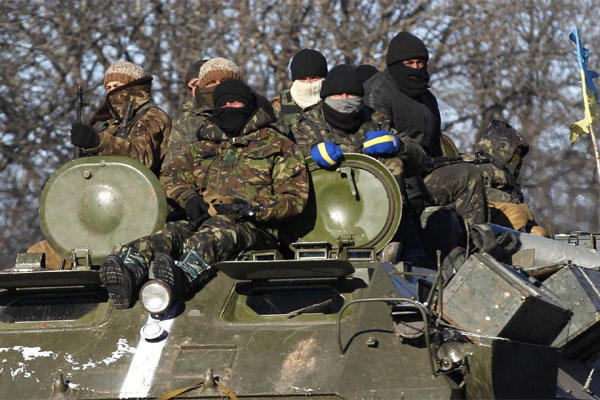The U.S. Army is working to glean intelligence on Russian military technology from the conflict between pro-Russian separatists and Ukrainian forces, American generals said.
The Moscow-backed rebels are waging a hybrid war that includes the use of soft power such as disinformation and cyberattacks to hard power such as truck-mounted Grad rocket launchers, according to Lt. Gen. Ben Hodges, commander of U.S. Army Europe.
U.S. Army leaders have found that American-supplied counter-mortar radar systems are helping Ukrainian forces detect incoming motor fire by calculating the point of origin of the enemy round, Hodges said. Washington reportedly supplied Kiev with 20 of the systems as part of an aid package valued at $118 million.
"Certainly, we're taking advantage of the opportunity to study what's being done in Crimea in Eastern Ukraine, where the Ukrainians have employed the counter-fire radar," he said on Tuesday in Huntsville, Alabama, during a conference organized by the Association of the United States Army.
"The lightweight counter-mortar radar, turns out, that it is a much better piece of equipment than we realized," Hodges said. "None of us have ever -- maybe one or two exceptions -- have ever been under a massive Russian artillery [attack] the way the Ukrainians have, and so we have learned a lot in the way that they have responded to that."
On the other hand, the conflict has exposed the potential for Russian electronic warfare technology to pierce U.S. and allied battlefield communications networks, Hodges and other U.S. generals said.
Rostec, a Russian-owned arms and technology company, last year claimed it used "complex radio-electronic" frequencies to hack into an MQ-5B Hunter drone that was flying over Crimea and belonged to the Army's 66th military intelligence brigade based in Germany.
"When you think of access denial, you think of Chinese Silkworm missiles and things like that," Hodges said, referring to sophisticated enemy air defenses, known in military parlance as anti-access, area-denial, or A2/AD environments.
"But actually to be able to project combat power into the Port of Riga [in Latvia], or Port of Bremerhaven or Ramstein [in Germany], there is so much reliance on network, and the Russians have demonstrated so much capability in Ukraine in their electronic warfare capabilities that makes it not almost impossible but extremely difficult to operate networks, especially if they're unsecured," he said.
The Army has spent billions of dollars trying to upgrade its battlefield communications networks through acquisition programs such as the Joint Tactical Radio System, or JTRS; Warfighter Information Network-Tactical, or WIN-T; and Nett Warrior. Some of these efforts have been canceled or restructured due to under-performing technology or changing requirements.
Despite those significant investments, the Army's tactical communications network remains problematic, incomplete and vulnerable to attack, according to Lt. Gen. H.R. McMaster, director of the Army Capabilities Integration Center.
"Just to talk air to ground, ground to air, to talk with adjacent units, we have a network that is incomplete and we have a network that is very complex," he said during the same panel at the conference. "Because of that complexity, it's vulnerable -- it's vulnerable to failure, it's vulnerable to enemy actions."
The service's shortcomings in tactical communications aren't limited to Eastern Europe.
In Afghanistan, AH-64E Apache pilots had difficulty receiving live video feeds from the RQ-7 Shadow drone because the helicopter uses a secure communications system called the tactical common data link while the unmanned aerial vehicle uses an older system.
"We couldn't see everybody else's video, so you go old school. You talk to the guy -- you talk to boots on the ground," said Lt. Col. John Davis, commander of 1st Battalion, 229th Aviation Regiment, part of the 16th Combat Aviation Brigade. "Actually, the E is ahead of its time when it comes to having the tactical common data link. Everybody at one point will be at that band on their systems. We're just ahead of it."
Maj. Gen. Dan Hughes, who oversees the service's programs for tactical command, control and communications, and other officials are working on solutions to the network problems, McMaster said.
"In the short term, what we need to do is harden our systems and make sure that they can degrade gracefully -- we can't have single points of failure," McMaster said. "We need really what are ... deterministic networks -- networks that can route communications even if certain nodes are disrupted. ... We also need a degree of redundancy."
Eventually, those technologies will need to be shared with NATO partners, Hodges said.
"If you accept the premise that we're always going to be part of an alliance or a coalition with alliance members, we're going to have to have networks that are interoperable, yet still have to protect your databases and your information, so that's a heck of a challenge for Army Cyber and our G-6 in the joint community, to be able to do that," he said.
McMaster also questioned the notion that a smaller but more technologically savvy Army will be adequate to combat future threats. After growing in size to 570,000 soldiers in 2008 at the height of the war in Iraq, the active component has less than 500,000 troops today and is on pace to shrink to 475,000 soldiers by next fiscal year.
"It has become an element of conventional wisdom that we can be prepared for the future -- future conflict -- by cutting capacity and manpower in the armed forces," he said. "And compensating for those cuts and making the force smaller with greater investments in high technology solutions to the problems of future war."
-- Brendan McGarry can be reached at Brendan.McGarry@military.com.


























